Post-Collisional Mantle Processes and Magma Evolution of the El Bola Mafic–Ultramafic Intrusion, Arabian-Nubian Shield, Egypt
Abstract
1. Introduction
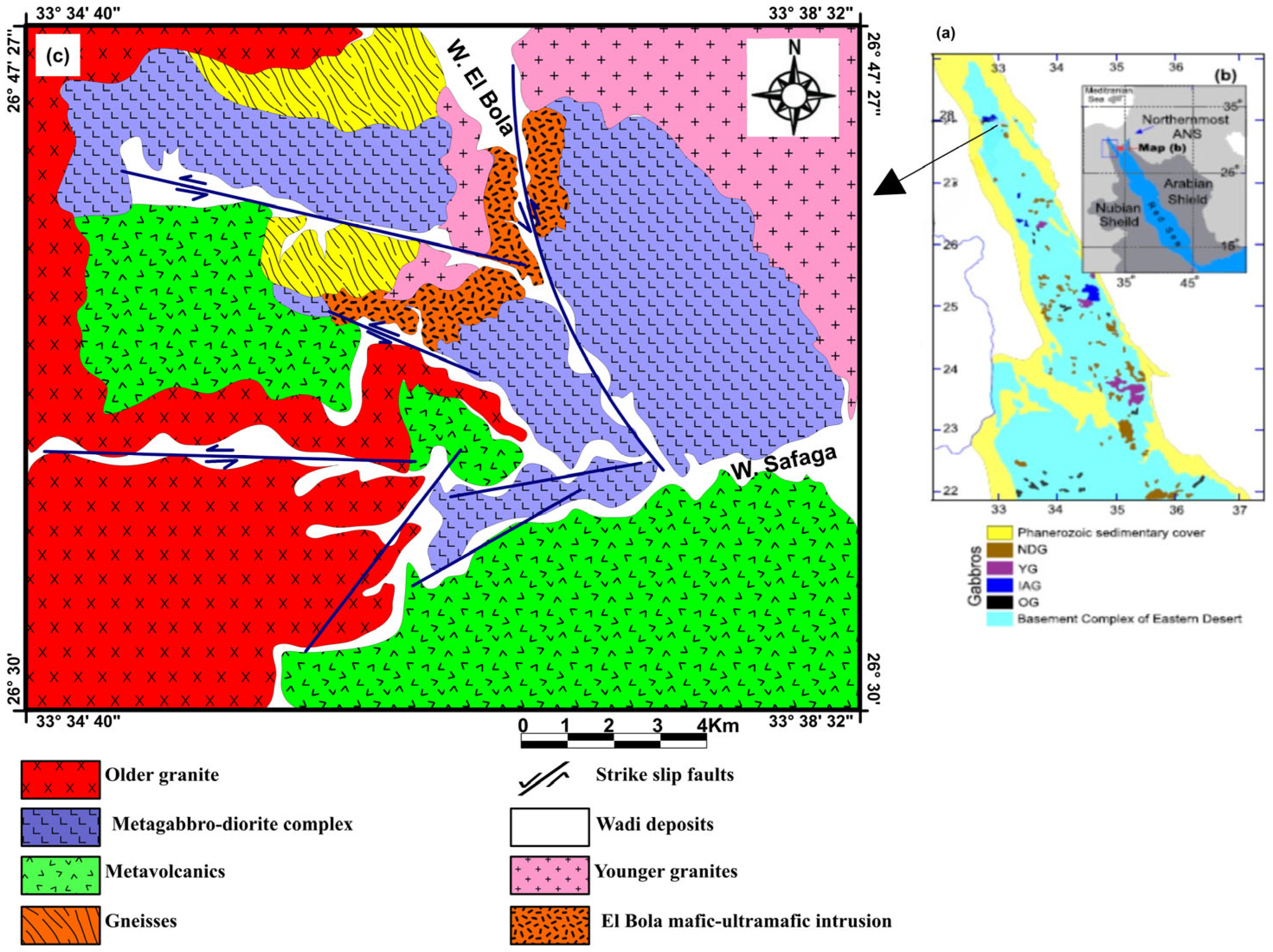
2. Geologic Setting
3. Petrographic Description of the EBMU Intrusion
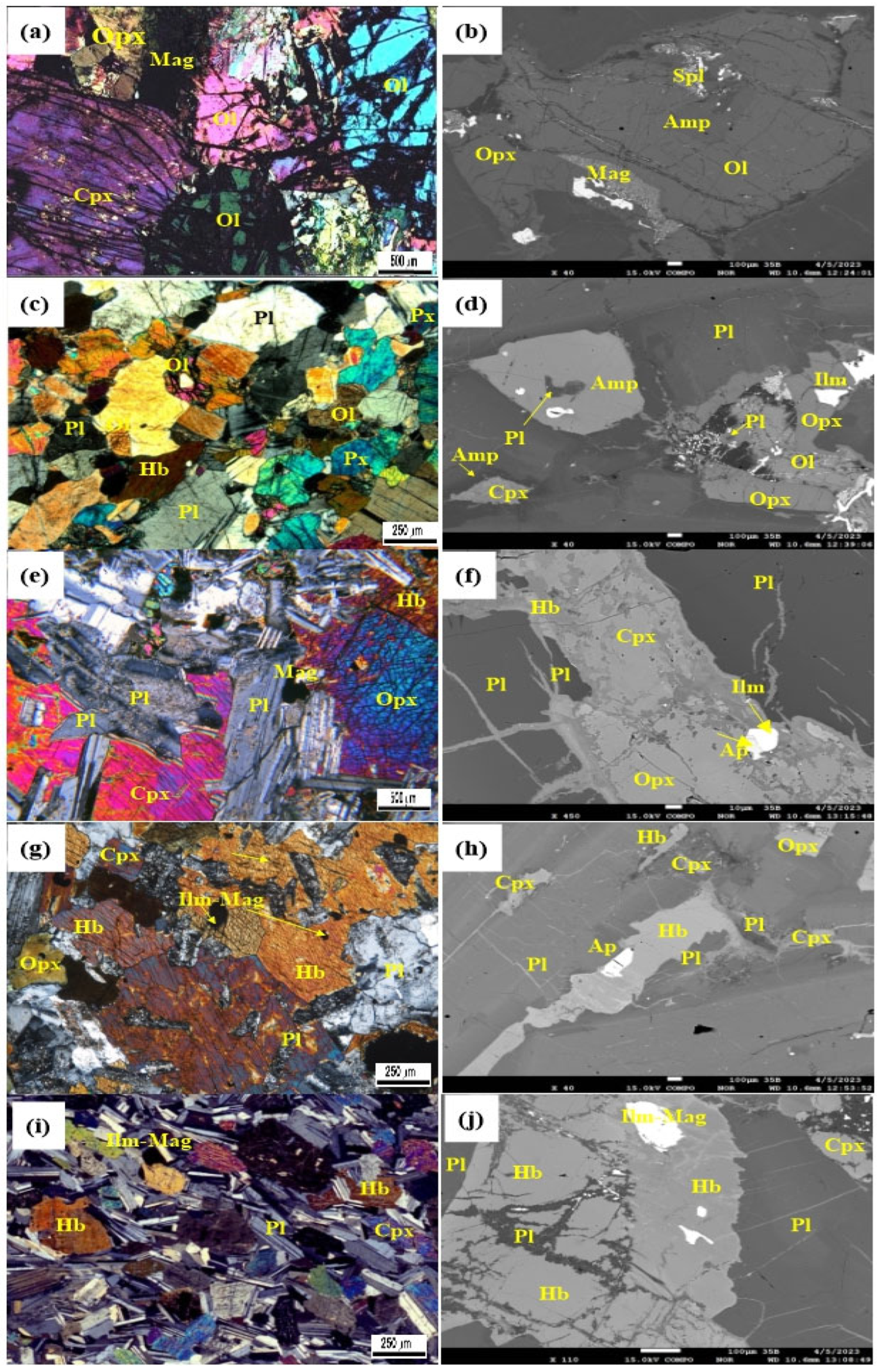
4. Materials and Methods
5. Results
5.1. Mineral Chemical Composition
5.1.1. Chromite
5.1.2. Olivine
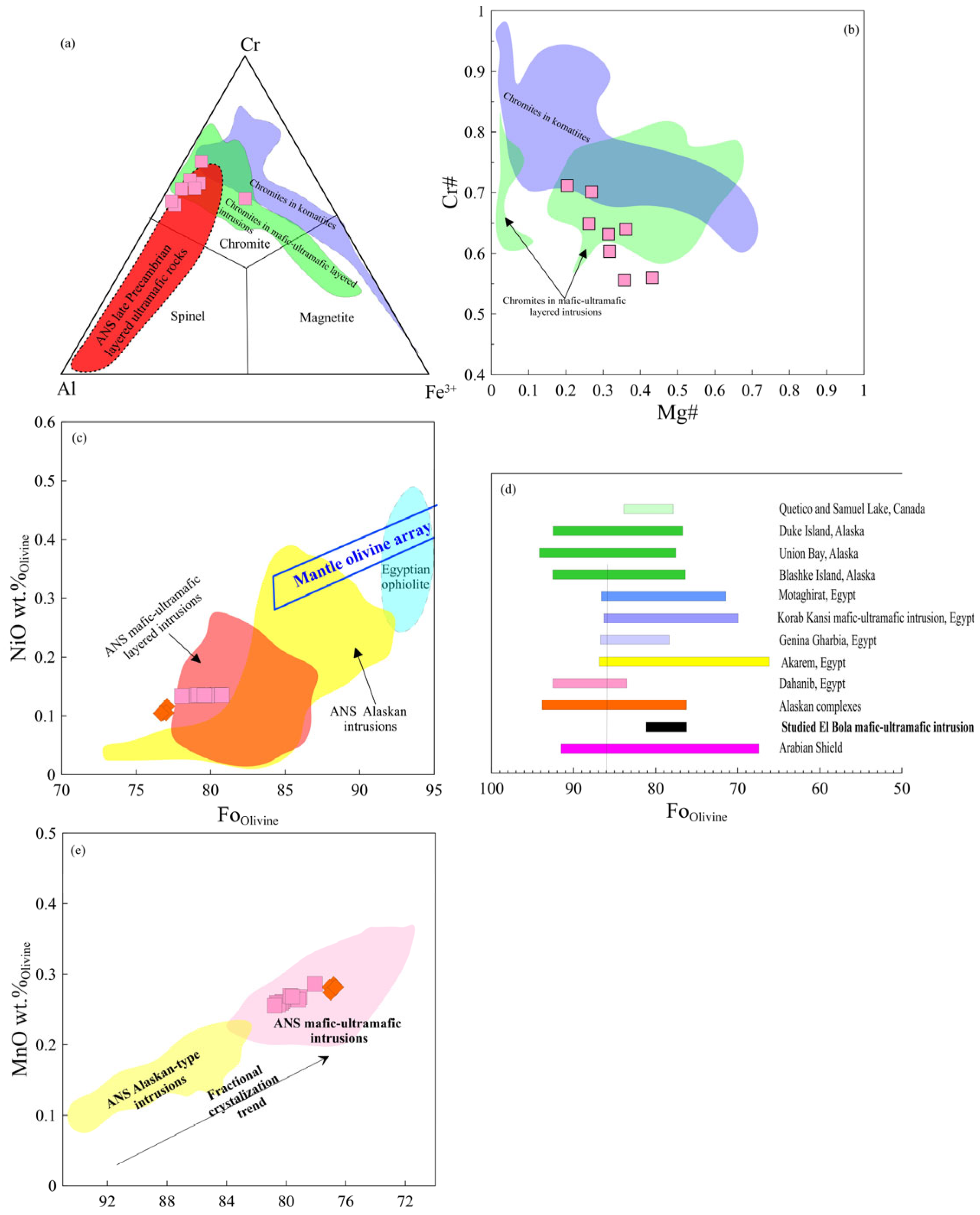
5.1.3. Pyroxenes
5.1.4. Amphiboles
5.1.5. Plagioclase
5.1.6. Oxide Minerals
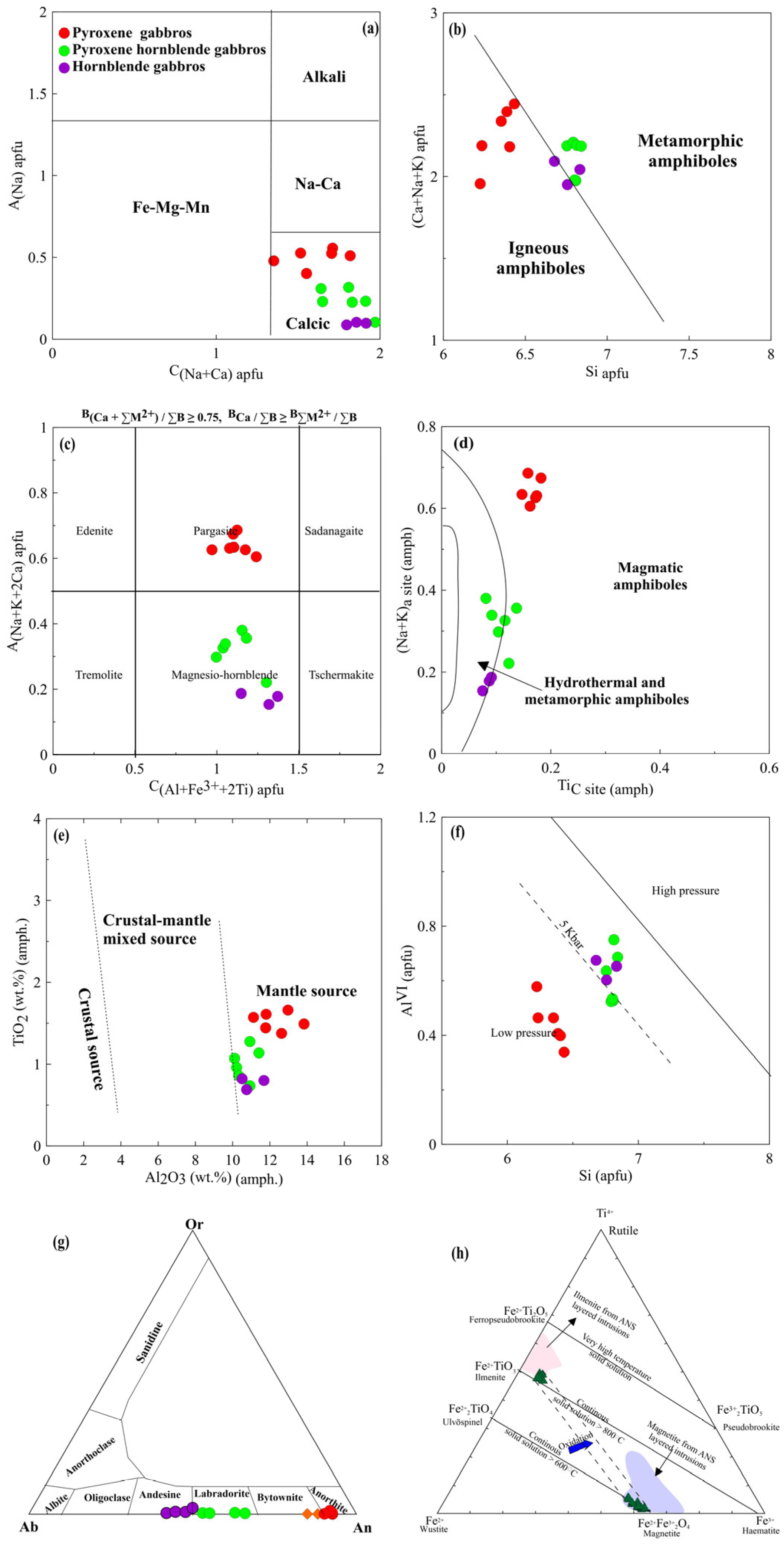
5.1.7. Whole-Rock Chemical Composition
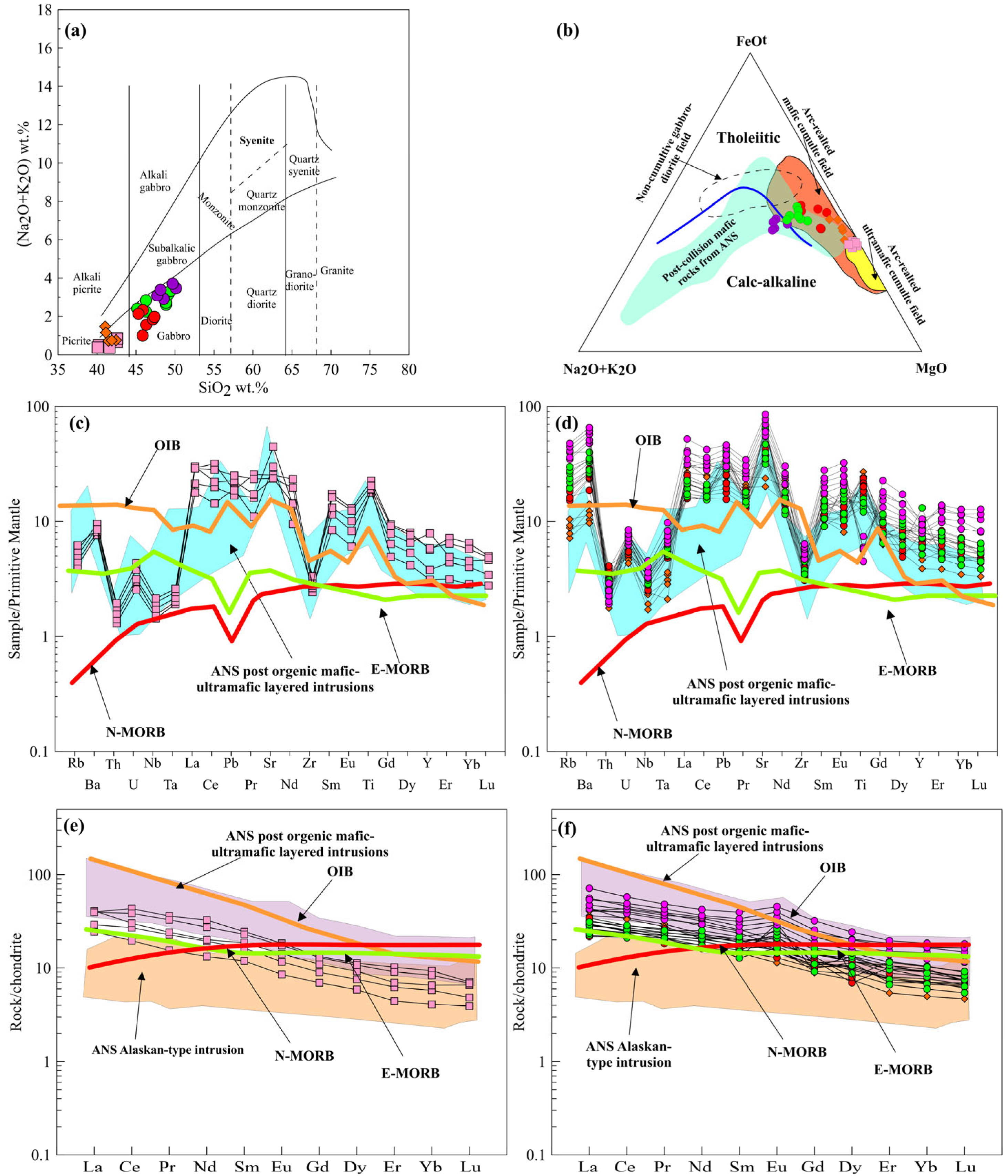
6. Discussion
6.1. Geothermobarometric Estimations of the EBMU Rocks
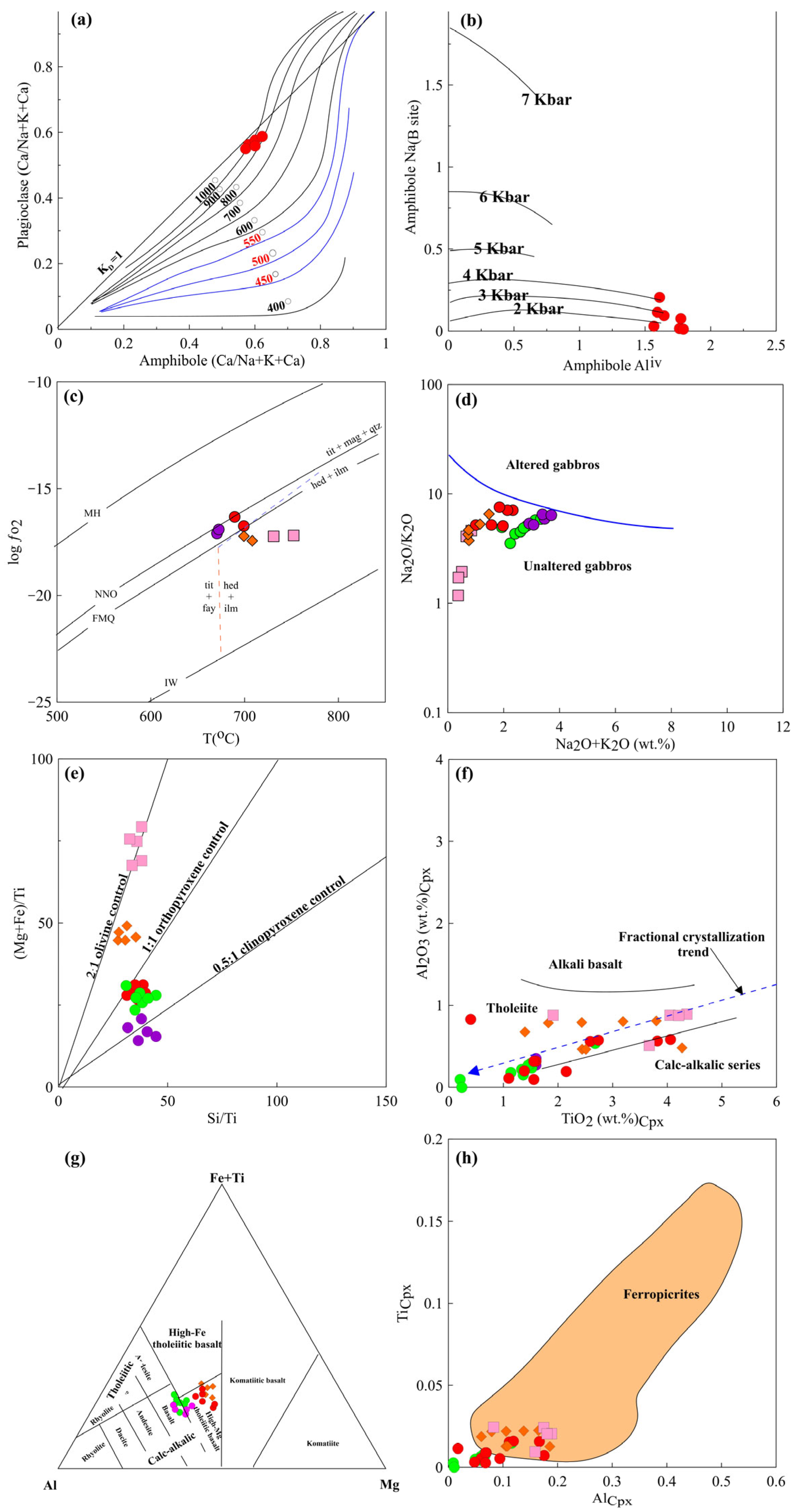
6.2. Post-Magmatic Overprints
6.3. Fractional Crystallization/Accumulation
6.4. Parental Magma Estimated Composition
6.5. Mantle Source Geochemical Characteristics

6.6. Tectonic Setting
7. Conclusions
Supplementary Materials
Author Contributions
Funding
Data Availability Statement
Conflicts of Interest
References
- Abuamarah, B.A. Characteristics and Petrogenesis of Neoproterozoic Mafic-Ultramafic Intrusions in the Arabian-Nubian Shield and the Question of Layered versus Alaskan-Type Intrusion. J. Geol. 2023, 131, 127–158. [Google Scholar] [CrossRef]
- Gahlan, H.A.; Azer, M.K.; Khalil, A.E. The Neoproterozoic Abu Dahr ophiolite, South Eastern Desert, Egypt: Petrological characteristics and tectonomagmatic evolution. Mineral. Petrol. 2015, 109, 611–630. [Google Scholar] [CrossRef]
- Obeid, M.A.; Khalil, A.E.; Azer, M.K. Mineralogy, geochemistry, and geotectonic significance of the Neoproterozoic ophiolite of Wadi Arais area, south Eastern Desert, Egypt. Int. Geol. Rev. 2016, 58, 687–702. [Google Scholar] [CrossRef]
- Abdel Halim, A.H.; Helmy, H.M.; Abd El-Rahman, Y.M.; Shibata, T.; El Mahallawi, M.M.; Yoshikawa, M.; Arai, S. Petrology of the Motaghairat mafic–ultramafic complex, Eastern Desert, Egypt: A high-Mg post-collisional extension-related layered intrusion. J. Asian Earth Sci. 2016, 116, 164–180. [Google Scholar] [CrossRef]
- Helmy, H.M.; El-Rahman, Y.M.A.; Yoshikawa, M.; Shibata, T.; Arai, S.; Tamura, A.; Kagami, H. Petrology and Sm–Nd dating of the Genina Gharbia Alaskan-type complex (Egypt): Insights into deep levels of Neoproterozoic island arcs. Lithos 2014, 198, 263–280. [Google Scholar] [CrossRef]
- Ali, B.; Wilde, S.; Gabr, M. Granitoid evolution in Sinai, Egypt, based on precise SHRIMP U–Pb zircon geochronology. Gondwana Res. 2009, 15, 38–48. [Google Scholar] [CrossRef]
- Mogahed, M.M.; Abdelfadil, K.M. Constraints of mantle and crustal sources interaction during orogenesis of pre-and post-collision granitoids from the Northern Arabian-Nubian shield: A case study from Wadi El-Akhder granitoids, southern Sinai, Egypt. Acta Geol. Sin. Engl. Ed. 2021, 95, 1527–1550. [Google Scholar] [CrossRef]
- Abdel-Karim, A.-A.M.; Azer, M.K.; Mogahed, M.M. Neoproterozoic concentric intrusive complex of gabbro-diorite-tonalite-granodiorite association, Rahaba area, southern Eastern Desert of Egypt: Implications for magma mixing of arc intrusive rocks. Lithos 2021, 404–405, 106423. [Google Scholar] [CrossRef]
- Khedr, M.Z.; Arai, S. Petrology of a Neoproterozoic Alaskan-type complex from the Eastern Desert of Egypt: Implications for mantle heterogeneity. Lithos 2016, 263, 15–32. [Google Scholar] [CrossRef]
- Mogahed, M.M.; Saad, W.M. Geotectonic significance of the Neoproterozoic ophiolitic metagabbros of Muiswirab area, South Eastern Desert, Egypt: Constraints from their mineralogical and geochemical characteristics. Acta Geochim. 2020, 39, 887–910. [Google Scholar] [CrossRef]
- Farahat, E. Chrome-spinels in serpentinites and talc carbonates of the El Ideid-El Sodmein District, central Eastern Desert, Egypt: Their metamorphism and petrogenetic implications. Chem. Der Erde Geochem. 2008, 68, 193–205. [Google Scholar] [CrossRef]
- Khedr, M.Z.; Arai, S. Origin of Neoproterozoic ophiolitic peridotites in south Eastern Desert, Egypt, constrained from primary mantle mineral chemistry. Mineral. Petrol. 2013, 107, 807–828. [Google Scholar] [CrossRef]
- Helmy, H.; El Mahallawi, M. Gabbro Akarem mafic-ultramafic complex, Eastern Desert, Egypt: A Late Precambrian analogue of Alaskan-type complexes. Mineral. Petrol. 2003, 77, 85–108. [Google Scholar] [CrossRef]
- Helmy, H.M.; Yoshikawa, M.; Shibata, T.; Arai, S.; Kagami, H. Sm–Nd and Rb–Sr isotope geochemistry and petrology of Abu Hamamid intrusion, Eastern Desert, Egypt: An Alaskan-type complex in a backarc setting. Precambrian Res. 2015, 258, 234–246. [Google Scholar] [CrossRef]
- Khedr, M.Z.; El-Awady, A.; Arai, S.; Hauzenberger, C.; Tamura, A.; Stern, R.J.; Morishita, T. Petrogenesis of the ~740 Korab Kansi mafic-ultramafic intrusion, South Eastern Desert of Egypt: Evidence of Ti-rich ferropicritic magmatism. Gondwana Res. 2020, 82, 48–72. [Google Scholar] [CrossRef]
- Khedr, M.Z.; Hauzenberger, C.; Morishita, T.; Tamura, A.; Bamousa, A.O.; Whattam, S.A.; Ali, S. The layered gabbroic intrusion in the Southern Eastern Desert of Egypt: Implications for Fe-Ti-rich magmatism at the end of the East African Orogeny. Geochemistry 2024, 84, 126077. [Google Scholar] [CrossRef]
- Eliwa, H.A.; Deevsalar, R.; Mahdy, N.M.; Pan, Y.; El-Gameel, K.; El-Desouky, H.A.; Khamis, H.; Murata, M.; Andresen, A.; Chew, D.; et al. Origin of Neoproterozoic anorthosites in the Wadi El Dib ultramafic-mafic layered intrusions, Egypt. Precambrian Res. 2025, 421, 107750. [Google Scholar] [CrossRef]
- Helmy, H.M.; Mogessie, A. Gabbro Akarem, Eastern Desert, Egypt: Cu-Ni-PGE mineralization in a concentrically zoned mafic-ultramafic complex. Mineral. Depos. 2001, 36, 58–71. [Google Scholar] [CrossRef]
- Khedr, M.Z.; Takazawa, E.; Arai, S.; Stern, R.J.; Morishita, T.; El-Awady, A. Styles of Fe–Ti–V ore deposits in the Neoproterozoic layered mafic-ultramafic intrusions, south Eastern Desert of Egypt: Evidence for fractional crystallization of V-rich melts. J. Afr. Earth Sci. 2022, 194, 104620. [Google Scholar] [CrossRef]
- Abdelfadil, K.M.; Asran, A.M.; Rehman, H.U.; Sami, M.; Ahmed, A.; Sanislav, I.V.; Fnais, M.S.; Mogahed, M.M. The Evolution of Neoproterozoic Mantle Peridotites Beneath the Arabian–Nubian Shield: Evidence from Wadi Sodmein Serpentinites, Central Eastern Desert, Egypt. Minerals 2024, 14, 1157. [Google Scholar] [CrossRef]
- Brooks, K. Layered Intrusions: Key to fundamental planetary processes. Geol. Today 2019, 35, 146–152. [Google Scholar] [CrossRef]
- Moores, E.M. Southwest U.S.-East Antarctic (SWEAT) connection: A hypothesis. Geology 1991, 19, 425–428. [Google Scholar] [CrossRef]
- Li, Z.X.; Li, X.H.; Kinny, P.D.; Wang, J. The breakup of Rodinia: Did it start with a mantle plume beneath South China? Earth Planet. Sci. Lett. 1999, 173, 171–181. [Google Scholar] [CrossRef]
- Pirajno, F. Hotspots and mantle plumes: Global intraplate tectonics, magmatism and ore deposits. Mineral. Petrol. 2004, 82, 183–216. [Google Scholar] [CrossRef]
- Zhao, J.-H.; Zhou, M.-F. Geochemistry of Neoproterozoic mafic intrusions in the Panzhihua district (Sichuan Province, SW China): Implications for subduction-related metasomatism in the upper mantle. Precambrian Res. 2007, 152, 27–47. [Google Scholar] [CrossRef]
- Mao, J.W.; Pirajno, F.; Zhang, Z.H.; Chai, F.M.; Wu, H.; Chen, S.P.; Cheng, L.S.; Yang, J.M.; Zhang, C.Q. A review of the Cu–Ni sulphide deposits in the Chinese Tianshan and Altay orogens (Xinjiang Autonomous Region, NW China): Principal characteristics and ore-forming processes. J. Asian Earth Sci. 2008, 32, 184–203. [Google Scholar] [CrossRef]
- Fiorentini, M.L.; Beresford, S.W.; Deloule, E.; Hanski, E.; Stone, W.E.; Pearson, N.J. The role of mantle-derived volatiles in the petrogenesis of Palaeoproterozoic ferropicrites in the Pechenga Greenstone Belt, northwestern Russia: Insights from in-situ microbeam and nanobeam analysis of hydromagmatic amphibole. Earth Planet. Sci. Lett. 2008, 268, 2–14. [Google Scholar] [CrossRef]
- Gamal El Dien, H.; Hamdy, M.; Abu El-Ela, A.S.; Abu-Alam, T.; Hassan, A.; Kil, Y.; Mizukami, T.; Soda, Y. Neoproterozoic serpentinites from the Eastern Desert of Egypt: Insights into Neoproterozoic mantle geodynamics and processes beneath the Arabian-Nubian Shield. Precambrian Res. 2016, 286, 213–233. [Google Scholar] [CrossRef]
- Farahat, E.; Mohamed, H.; Ahmed, A.; El Mahallawi, M. Origin of I- and A-type granitoids from the Eastern Desert of Egypt: Implications for crustal growth in the northern Arabian–Nubian Shield. J. Afr. Earth Sci. 2007, 49, 43–58. [Google Scholar] [CrossRef]
- El-Shazly, S.M.; El-Sayed, M.M. Petrogenesis of the Pan-African El-Bula Igneous Suite, central Eastern Desert, Egypt. J. Afr. Earth Sci. 2000, 31, 317–336. [Google Scholar] [CrossRef]
- EL Gaby, S.; Habib, M.S. Geology of the area southwest of Port Safaga, with special emphasis on the granitic rocks, Eastern Desert, Egypt. Ann. Geol. Surv. Egypt 1982, 12, 47–71. [Google Scholar]
- Stern, R.J.; Gottfried, D.; Hedge, C.E. Late Precambrian rifting and crustal evolution in the Northeastern Desert of Egypt. Geology 1984, 12, 168–172. [Google Scholar] [CrossRef]
- Khedr, M.Z.; Moftah, A.; El-Shibiny, N.H.; Tamura, A.; Tan, W.; Ichiyama, Y.; Takazawa, E.; Kahal, A.Y.; Abdelrahman, K. Mineralogy and Geochemistry of Titaniferous Iron Ores in El-Baroud Layered Gabbros: Fe-Ti Ore Genesis and Tectono-Metallogenetic Setting. Minerals 2024, 14, 679. [Google Scholar] [CrossRef]
- Abdelfadil, K.M.; Saleh, G.M.; Putiš, M.; Sami, M. Mantle source characteristics of the late Neoproterozoic post-collisional gabbroic intrusion of Wadi Abu Hadieda, north Arabian-Nubian Shield, Egypt. J. Afr. Earth Sci. 2022, 194, 104607. [Google Scholar] [CrossRef]
- Stern, R.J. Petrogenesis and tectonic setting of Late Precambrian ensimatic volcanic rocks, Central Eastern Desert of Egypt. Precambrian Res. 1981, 16, 195–230. [Google Scholar] [CrossRef]
- Stern, R.J. Neoproterozoic formation and evolution of Eastern Desert continental crust–The importance of the infrastructure-superstructure transition. J. Afr. Earth Sci. 2018, 146, 15–27. [Google Scholar] [CrossRef]
- Abdel-Rahman, A.-F.M. Mineralogy of the Neoproterozoic epidote-bearing TTG suite, Mons Claudianus batholith (Egypt) and implications for synorogenic magmatism. Mineral. Mag. 2016, 80, 1291–1314. [Google Scholar] [CrossRef]
- Abdelfadil, K.M.; Mansour, S.; Asran, A.M.; Younis, M.H.; Lentz, D.R.; Fowler, A.-R.; Fnais, M.S.; Abdelrahman, K.; Radwan, A. Composite Granitic Plutonism in the Southern Part of the Wadi Hodein Shear Zone, South Eastern Desert, Egypt: Implications for Neoproterozoic Dioritic and Highly Evolved Magma Mingling during Volcanic Arc Assembly. Minerals 2024, 14, 1002. [Google Scholar] [CrossRef]
- Lasheen, E.S.R.; Abart, R.; Ahmed, M.S.; Abdelfadil, K.M.; Farahat, E.S.; Sami, M. Petrological constraints of the Ediacaran magmatic intrusions, Homrit Mukpid area, southeastern Desert, Egypt: Bulk rock geochemistry and mineralogy. J. Afr. Earth Sci. 2025, 225, 105567. [Google Scholar] [CrossRef]
- Le Bas, M.J.; Streckeisen, A.L. The IUGS systematics of igneous rocks. J. Geol. Soc. 1991, 148, 825–833. [Google Scholar] [CrossRef]
- Whitney, D.L.; Evans, B.W. Abbreviations for names of rock-forming minerals. Am. Mineral. 2010, 95, 185–187. [Google Scholar] [CrossRef]
- Imai, N.; Terashima, S.; Itoh, S.; Ando, A. 1994 compilation values for GSJ reference samples, “Igneous rock series&rdquo. Geochem. J. 1995, 29, 91–95. [Google Scholar] [CrossRef]
- Barnes, S.J.; Roeder, P.L. The range of spinel compositions in terrestrial mafic and ultramafic rocks. J. Petrol. 2001, 42, 2279–2302. [Google Scholar] [CrossRef]
- Azer, M.K.; Stern, R.J. Neoproterozoic (835–720 Ma) serpentinites in the Eastern Desert, Egypt: Fragments of forearc mantle. J. Geol. 2007, 115, 457–472. [Google Scholar] [CrossRef]
- Azer, M.; El-Gharbawy, R. The Neoproterozoic layered mafic–ultramafic intrusion of Gabal Imleih, south Sinai, Egypt: Implications of post-collisional magmatism in the north Arabian–Nubian Shield. J. Afr. Earth Sci. 2011, 60, 253–272. [Google Scholar] [CrossRef]
- Takahashi, E.; Uto, K.; Schilling, J.-G. Primary Magma Compositions and Mg/Fe Ratios of Their Mantle Residues Along Mid Atlantic Ridge 29°/to 73° N; Okayama University: Tottori Prefecture, Japan, 1987. [Google Scholar]
- Khedr, M.Z.; Arai, S. Peridotite-chromitite complexes in the Eastern Desert of Egypt: Insight into Neoproterozoic sub-arc mantle processes. Gondwana Res. 2017, 52, 59–79. [Google Scholar] [CrossRef]
- Farahat, E.; Helmy, H. Abu Hamamid Neoproterozoic Alaskan-type complex, South Eastern Desert, Egypt. J. Afr. Earth Sci. 2006, 45, 187–197. [Google Scholar] [CrossRef]
- Mogahed, M.M. Petrogenesis of Zeiatit gabbroic rocks in the Southern Eastern Desert of Egypt: Discrimination of arc-related Neoproterozoic gabbros. J. Afr. Earth Sci. 2019, 150, 239–263. [Google Scholar] [CrossRef]
- Mogahed, M.M. Genesis and Tectonic Implications of the Kabr El-Bonaya Ultramafic Rocks, Sinai Peninsula, Egypt: Constraints from Mineralogical and Geochemical Characteristics. Acta Geol. Sin. Engl. Ed. 2021, 95, 393–418. [Google Scholar] [CrossRef]
- Khudeir, A. El-Genina El-Gharbia and El-Genina El-Sharkia ultramafic-mafic intrusions, Eastern Desert, Egypt: Geology, petrology, geochemistry and petrogenesis. Assiut University. Bull. Fac. Sci. 1995, 2, 177–219. [Google Scholar]
- Abd El-Rahman, Y.A.; Helmy, H.M.; Shibata, T.; Yoshikawa, M.; Arai, S.; Tamura, A. Mineral chemistry of the Neoproterozoic Alaskan-type Akarem Intrusion with special emphasis on amphibole: Implications for the pluton origin and evolution of subduction-related magma. Lithos 2012, 155, 410–425. [Google Scholar] [CrossRef]
- Morimoto, N.; Fabries, J.; Ferguson, A.K.; Ginzburg, I.V.; Ross, M.; Seifert, F.A.; Zussman, J. Nomenclature of pyroxenes. Mineral. Mag. 1988, 52, 535–550. [Google Scholar] [CrossRef]
- Barnes, S.J. Chromite in Komatiites, 1. Magmatic Controls on Crystallization and Composition. J. Petrol. 1998, 39, 1689–1720. [Google Scholar] [CrossRef]
- Chistyakov, A.V.; Sharkov, E.V. Petrology of the Early Paleoproterozoic Burakovsky complex, southern Karelia. Petrology 2008, 16, 63–86. [Google Scholar] [CrossRef]
- Azer, M.; Obeid, M.; Gahlan, H. Late Neoproterozoic layered mafic intrusion of arc-affinity in the Arabian-Nubian Shield: A case study from the Shahira layered mafic intrusion, southern Sinai, Egypt. Geol. Acta 2016, 14, 237–259. [Google Scholar] [CrossRef]
- Essawy, M.A.; El-Metwally, A.A.; Althaus, E. Pan-African layered mafic-ultramafic-mafic cumulate complex in the SW Sinai massif: Mineralogy, geochemistry and crustal growth. Chem. Erde 1997, 57, 137–156. [Google Scholar]
- Khudeir, A. Chromian spinel-silicate chemistry in peridotite and orthopyroxenite relicts from ophiolitic serpentinites, Eastern Desert, Egypt. Bull. Fac. Sci. Assiut Univ. 1995, 24, 221–261. [Google Scholar]
- Pettigrew, N.T.; Hattori, K.H. The Quetico intrusions of western Superior Province: Neo-Archean examples of Alaskan/Ural-type mafic–ultramafic intrusions. Precambrian Res. 2006, 149, 21–42. [Google Scholar] [CrossRef]
- Irvine, T.N. Petrology of the Duke Island Ultramafic Complex, Southeastern Alaska; Geological Society of America Memoir: Boulder, CO, USA, 1974; Volume 138, p. 240. [Google Scholar]
- Himmelberg, G.R.; Loney, R.A.; Craig, J.T. Petrogenesis of the Ultramafic Complex at the Blashke Islands, Southeastern Alaska; Department of the Interior, US Geological Survey: Reston, VA, USA, 1986. [Google Scholar]
- Habtoor, A.; Ahmed, A.H.; Harbi, H. Petrogenesis of the Alaskan-type mafic–ultramafic complex in the Makkah quadrangle, western Arabian Shield, Saudi Arabia. Lithos 2016, 263, 33–51. [Google Scholar] [CrossRef]
- Tuff, J.; Takahashi, E.; Gibson, S.A. Experimental Constraints on the Role of Garnet Pyroxenite in the Genesis of High-Fe Mantle Plume Derived Melts. J. Petrol. 2005, 46, 2023–2058. [Google Scholar] [CrossRef]
- Lindsley, D.H. Pyroxene thermometry. Am. Mineral. 1983, 68, 477–493. [Google Scholar]
- Rietmeijer, F.J.M. Chemical distinction between igneous and metamorphic orthopyroxenes especially those coexisting with Ca-rich clinopyroxenes: A re-evaluation. Mineral. Mag. 1983, 47, 143–151. [Google Scholar] [CrossRef]
- DeBari, S.M.; Coleman, R.G. Examination of the deep levels of an island arc: Evidence from the Tonsina Ultramafic-Mafic Assemblage, Tonsina, Alaska. J. Geophys. Res. Solid Earth 1989, 94, 4373–4391. [Google Scholar] [CrossRef]
- Johnson, K.T.; Dick, H.J.; Shimizu, N. Melting in the oceanic upper mantle: An ion microprobe study of diopsides in abyssal peridotites. J. Geophys. Res. Solid Earth 1990, 95, 2661–2678. [Google Scholar] [CrossRef]
- Ishii, T.; Robinson, P.T.; Hirokazu, M.; Richard, F. Petrological studies of peridotites from diapiric serpentinite seamounts in the Izu-Ogasawara-Mariana forearc, Leg 125. In Proceedings of the Ocean Drilling Program, Scientific Results, Texas A & M University, Ocean Drilling Program, College Station, TX, USA, 19 May–20 July 1992; pp. 445–485. [Google Scholar]
- Van der Laan, S.R.; Arculus, R.; Pearce, J.; Murton, B.; Fryer, P. Petrography, mineral chemistry, and phase relations of the basement boninite series of Site 786, Izu-Bonin forearc. In Proceedings of the Ocean Drilling Program, Scientific Results, College Station, TX, USA, 19 May–20 July 1992; pp. 171–201. [Google Scholar]
- Constantin, M. Gabbroic intrusions and magmatic metasomatism in harzburgites from the Garrett transform fault: Implications for the nature of the mantle–crust transition at fast-spreading ridges. Contrib. Mineral. Petrol. 1999, 136, 111–130. [Google Scholar] [CrossRef]
- Loucks, R.R. Discrimination of ophiolitic from nonophiolitic ultramafic-mafic allochthons in orogenic belts by the Al/Ti ratio in clinopyroxene. Geology 1990, 18, 346–349. [Google Scholar] [CrossRef]
- Himmelberg, G.R.; Loney, R.A. Characteristics and petrogenesis of Alaskan-type ultramafic-mafic intrusions, southeastern Alaska. In U.S. Geological Survey Professional Paper 1564; Generic: Melbourne, Australia, 1995. [Google Scholar]
- Hawthorne, F.C.; Oberti, R.; Harlow, G.E.; Maresch, W.V.; Martin, R.F.; Schumacher, J.C.; Welch, M.D. Nomenclature of the amphibole supergroup. Am. Mineral. 2012, 97, 2031–2048. [Google Scholar] [CrossRef]
- Stormer, J.C. The effects of recalculation on estimates of temperature and oxygen fugacity from analyses of multicomponent iron-titanium oxides. Am. Mineral. 1983, 68, 586–594. [Google Scholar]
- Robinson, P.; Panish, P.T.; McEnroe, S.A. Minor element chemistry of hemo-ilmenite and magnetite in cumulate rocks from the Sokndal Region, South Rogaland, Norway. Am. Mineral. 2001, 86, 1469–1476. [Google Scholar] [CrossRef]
- Toplis, M.J.; Corgne, A. An experimental study of element partitioning between magnetite, clinopyroxene and iron-bearing silicate liquids with particular emphasis on vanadium. Contrib. Mineral. Petrol. 2002, 144, 22–37. [Google Scholar] [CrossRef]
- Leake, B.E.; Wooley, A.R.; Arps, C.E.; Birch, W.D.; Gilbert, M.C.; Grice, J.D.; Hawthorne, F.C.; Kato, A.; Kisch, H.J.; Krivovichec, V. Nomenclature of amphiboles; report of the Subcommittee on amphiboles of the International Mineralogical Association Commission on New Minerals and Mineral Names. Eur. J. Mineral. 1997, 9, 623–651. [Google Scholar] [CrossRef]
- Giret, A.; Bonin, B.; Leger, J.-M. Amphibole compositional trends in oversaturated and undersaturated alkaline plutonic ring-composition. Can. Mineral. 1980, 18, 481–495. [Google Scholar]
- Girardeau, J.; Mevel, C. Amphibolitized sheared gabbros from ophiolites as indicators of the evolution of the oceanic crust: Bay of Islands, Newfoundland. Earth Planet. Sci. Lett. 1982, 61, 151–165. [Google Scholar] [CrossRef]
- Jiang, C.Y.; An, S.Y. On chemical characteristics of calcific amphiboles from igneous rocks and their petrogenesis significance. J. Mineral. Petrol. 1984, 3, 1–9. [Google Scholar]
- Raase, P. Al and Ti contents of hornblende, indicators of pressure and temperature of regional metamorphism. Contrib. Mineral. Petrol. 1974, 45, 231–236. [Google Scholar] [CrossRef]
- Deer, W.; Howie, R.; Zussman, J. An Introduction to the Rock-Forming Minerals, 2nd ed.; Longman Scientific & Technical: Harlow, Essex, UK; New York, NY, USA, 1992; p. 696. [Google Scholar]
- Buddington, A.; Lindsley, D. Iron-titanium oxide minerals and synthetic equivalents. J. Petrol. 1964, 5, 310–357. [Google Scholar] [CrossRef]
- Finger, F.; Broska, I.; Haunschmid, B.; Hrasko, L.; Kohút, M.; Krenn, E.; Petrík, I.; Riegler, G.; Uher, P. Electron-microprobe dating of monazites from Western Carpathian basement granitoids: Plutonic evidence for an important Permian rifting event subsequent to Variscan crustal anatexis. Int. J. Earth Sci. 2003, 92, 86–98. [Google Scholar] [CrossRef]
- Gibson, S.A.; Thompson, R.N.; Dickin, A.P. Ferropicrites: Geochemical evidence for Fe-rich streaks in upwelling mantle plumes. Earth Planet. Sci. Lett. 2000, 174, 355–374. [Google Scholar] [CrossRef]
- Be’eri-Shlevin, Y.; Katzir, Y.; Whitehouse, M. Post-collisional tectonomagmatic evolution in the northern Arabian–Nubian Shield: Time constraints from ion-probe U–Pb dating of zircon. J. Geol. Soc. 2009, 166, 71–85. [Google Scholar] [CrossRef]
- Condie, K.C. Geochemical changes in baslts and andesites across the Archean-Proterozoic boundary: Identification and significance. Lithos 1989, 23, 1–18. [Google Scholar] [CrossRef]
- Pearce, J.A.; Peate, D.W. Tectonic implications of the composition of volcanic arc magmas. Annu. Rev. Earth Planet. Sci. 1995, 23, 251–285. [Google Scholar] [CrossRef]
- Middlemost, E.A.K. Naming materials in the magma/igneous rock system. Earth Sci. Rev. 1994, 37, 215–224. [Google Scholar] [CrossRef]
- Bas, M.J.L.; Maitre, R.W.L.; Streckeisen, A.; Zanettin, B.; IUGS Subcommission on the Systematics of Igneous Rocks. A Chemical Classification of Volcanic Rocks Based on the Total Alkali-Silica Diagram. J. Petrol. 1986, 27, 745–750. [Google Scholar] [CrossRef]
- Irvine, T.; Baragar, W. A guide to the chemical classification of the common volcanic rocks. Can. J. Earth Sci. 1971, 8, 523–548. [Google Scholar] [CrossRef]
- Beard, J.S. Characteristic mineralogy of arc-related cumulate gabbros: Implications for the tectonic setting of gabbroic plutons and for andesite genesis. Geology 1986, 14, 848–851. [Google Scholar] [CrossRef]
- Sun, S.-S.; McDonough, W. Chemical and isotopic systematics of oceanic basalts: Implications for mantle composition and processes. J. Geol. Soc. London Spec. Pub. 1989, 42, 313–345. [Google Scholar] [CrossRef]
- Wells, P.R.A. Pyroxene thermometry in simple and complex systems. Contrib. Mineral. Petrol. 1977, 62, 129–139. [Google Scholar] [CrossRef]
- Putirka, K. Thermometers and barometers for volcanic systems. Rev. Mineral. Geochem. 2008, 69, 61–120. [Google Scholar] [CrossRef]
- Putirka, K. Rates and styles of planetary cooling on Earth, Moon, Mars, and Vesta, using new models for oxygen fugacity, ferric-ferrous ratios, olivine-liquid Fe-Mg exchange, and mantle potential temperature. Am. Mineral. 2016, 101, 819–840. [Google Scholar] [CrossRef]
- Blundy, J.D.; Holland, T.J. Calcic amphibole equilibria and a new amphibole-plagioclase geothermometer. Contrib. Mineral. Petrol. 1990, 104, 208–224. [Google Scholar] [CrossRef]
- Ulrych, J.; Cimbalnikova, A.; Fiala, I.; Kaspar, P.; Lang, M.; Minarik, L.; Palivcova, M.; Pivec, E. Petrology of the Petrovice metagabbro. Rozpr. Ceskoslov. Akad. Věd Řada Mat. Prir. Věd 1976, 86, 57. [Google Scholar]
- Andersen, D. New (and final!) models for the Ti-magnetite/ilmenite geothermometer and oxygen barometer. In Proceedings of the Abstracts of American Geophysical Union 1985 Spring Meeting, Baltimore, MD, USA, 14–17 May 1985; American Geophysical Union: Florida Avenue, NW, USA, 1985. [Google Scholar]
- Brown, E. The crossite content of Ca-amphibole as a guide to pressure of metamorphism. J. Petrol. 1977, 18, 53–72. [Google Scholar] [CrossRef]
- Frost, B.R. Introduction to oxygen fugacity and its petrologic importance. In Oxide Minerals; De Gruyter: Berlin, Germany, 1991; pp. 1–10. [Google Scholar]
- Wones, D.R. Significance of the assemblage titanite+magnetite+quartz in granitic rocks. Am. Mineral. 1989, 74, 744–749. [Google Scholar]
- Miyashiro, A. Volcanic Rock Series and Tectonic Setting. Annu. Rev. Earth Planet. Sci. 1975, 3, 251–269. [Google Scholar] [CrossRef]
- Nicholls, J.; Russell, J.K. Igneous rock associations 20. Pearce element ratio diagrams: Linking geochemical data to magmatic processes. Geosci. Can. 2016, 43, 133–146. [Google Scholar] [CrossRef]
- Ulrych, J. Clinopyroxenes in the Cenozoix volcanics of the Ceské stredohori MTS.: A review. Acta Univ. Carolinae. Geol. 1986, 4, 367–376. [Google Scholar]
- Jensen, L.S. A new cation plot for classifying subalkalic volcanic rocks. Ont. Div. Mines Misc. Pap. 1976, 66, 22. [Google Scholar]
- Ghiorso, M.S.; Evans, B.W. Thermodynamics of rhombohedral oxide solid solutions and a revision of the Fe-Ti two-oxide geothermometer and oxygen-barometer. Am. J. Sci. 2008, 308, 957–1039. [Google Scholar] [CrossRef]
- Ballhaus, C.; Berry, R.F.; Green, D.H. Oxygen fugacity controls in the Earth’s upper mantle. Nature 1990, 348, 437–440. [Google Scholar] [CrossRef]
- Smith, W.D.; Jenkins, M.C.; Augustin, C.T.; Virtanen, V.J.; Vukmanovic, Z.; O’Driscoll, B. Layered intrusions in the Precambrian: Observations and perspectives. Precambrian Res. 2024, 415, 107615. [Google Scholar] [CrossRef]
- Polat, A.; Hofmann, A.W. Alteration and geochemical patterns in the 3.7–3.8 Ga Isua greenstone belt, West Greenland. Precambrian Res. 2003, 126, 197–218. [Google Scholar] [CrossRef]
- Rudnick, R.; Gao, S. Composition of the continental crust. Treatise Geochem. 2003, 3, 659. [Google Scholar]
- Kerrich, R.; Polat, A.; Wyman, D.; Hollings, P. Trace element systematics of Mg-, to Fe-tholeiitic basalt suites of the Superior Province: Implications for Archean mantle reservoirs and greenstone belt genesis. Lithos 1999, 46, 163–187. [Google Scholar] [CrossRef]
- Plank, T. Constraints from Thorium/Lanthanum on Sediment Recycling at Subduction Zones and the Evolution of the Continents. J. Petrol. 2005, 46, 921–944. [Google Scholar] [CrossRef]
- Bi, J.H.; Ge, W.C.; Yang, H.; Zhao, G.C.; Xu, W.L.; Wang, Z.H. Geochronology, geochemistry and zircon Hf isotopes of the Dongfanghong gabbroic complex at the eastern margin of the Jiamusi Massif, NE China: Petrogensis and tectonic implications. Lithos 2015, 234–235, 27–46. [Google Scholar] [CrossRef]
- Hofmann, A. Mantle geochemistry: The message from oceanic volcanism. Nature 1997, 385, 219–229. [Google Scholar] [CrossRef]
- Song, X.-Y.; Li, X.-R. Geochemistry of the Kalatongke Ni–Cu–(PGE) sulfide deposit, NW China: Implications for the formation of magmatic sulfide mineralization in a postcollisional environment. Mineral. Depos. 2009, 44, 303–327. [Google Scholar] [CrossRef]
- Stewart, B.W.; DePaolo, D.J. Isotopic Studies of Processes in Mafic Magma Chambers: III. the Muskox Intrusion, Northwest Territories, Canada. In Earth Processes: Reading the Isotopic Code; Geophysical Monograph Series: Washington, DC, USA, 1996; pp. 277–292. [Google Scholar]
- Bai, Z.-J.; Zhong, H.; Naldrett, A.J.; Zhu, W.-G.; Xu, G.-W. Whole-Rock and Mineral Composition Constraints on the Genesis of the Giant Hongge Fe-Ti-V Oxide Deposit in the Emeishan Large Igneous Province, Southwest China. Econ. Geol. 2012, 107, 507–524. [Google Scholar] [CrossRef]
- Clarke, D. The mineralogy of peraluminous granites; a review. Can. Mineral. 1981, 19, 3–17. [Google Scholar]
- Roeder, P.; Emslie, R. Olivine-Liquid Equilibrium. Contrib. Mineral. Petrol. 1970, 29, 275–289. [Google Scholar] [CrossRef]
- Ross, J.R.; Travis, G.A. The nickel sulfide deposits of Western Australia in global perspective. Econ. Geol. 1981, 76, 1291–1329. [Google Scholar] [CrossRef]
- Wei, X.; Xieyan, S.; Yufeng, D.; LieMeng, C.; XiaoQi, Z.; WenQin, Z.; Xun, W. Geology and olivine geochemistry of the Heishan Ni-Cu-(PGE) sulfide deposit, Gansu, NW China. Acta Petrol. Sin. 2013, 29, 3487–3502, (In Chinese with English Abstract). [Google Scholar]
- Li, C.; Ripley, E.M. The Giant Jinchuan Ni-Cu-(PGE) Deposit: Tectonic Setting, Magma Evolution, Ore Genesis, and Exploration Implications. Rev. Econ. Geol. 2011, 17, 163–180. [Google Scholar] [CrossRef]
- Hoyer, P.A.; Haase, K.M.; Regelous, M.; O’Connor, J.M.; Homrighausen, S.; Geissler, W.H.; Jokat, W. Mantle plume and rift-related volcanism during the evolution of the Rio Grande Rise. Commun. Earth Environ. 2022, 3, 18. [Google Scholar] [CrossRef]
- Zhang, Z.; Mao, J.; Saunders, A.D.; Ai, Y.; Li, Y.; Zhao, L. Petrogenetic modeling of three mafic–ultramafic layered intrusions in the Emeishan large igneous province, SW China, based on isotopic and bulk chemical constraints. Lithos 2009, 113, 369–392. [Google Scholar] [CrossRef]
- Sisson, T.; Grove, T. Experimental investigations of the role of H2O in calc-alkaline differentiation and subduction zone magmatism. Contrib. Mineral. Petrol. 1993, 113, 143–166. [Google Scholar] [CrossRef]
- Desta, M.T.; Ayalew, D.; Ishiwatari, A.; Arai, S.; Tamura, A. Ferropicrite from the Lalibela area in the Ethiopian large igneous province. J. Mineral. Petrol. Sci. 2014, 109, 191–207. [Google Scholar] [CrossRef]
- Li, L.; Zhang, D.; Tan, S.; Sun, F.; Wang, C.; Zhao, T.; Li, S.; Yang, Y. The parental magma composition, crustal contamination process, and metallogenesis of the Shitoukengde Ni-Cu sulfide deposit in the Eastern Kunlun Orogenic Belt, NW China. Resour. Geol. 2021, 71, 339–362. [Google Scholar] [CrossRef]
- Yuan, F.; Zhou, T.F.; Zhang, D.Y.; Fan, Y.; Liu, S.; Peng, M.; Zhang, J.D. Source, evolution and tectonic setting of the basalts from the native copper mineralization area in eastern Tianshan, Xinjiang. Acta Petrol. Sin. 2010, 26, 533–546, (In Chinese with English Abstract). [Google Scholar]
- Tang, D.; Qin, K.; Li, C.; Qi, L.; Su, B.; Qu, W. Zircon dating, Hf–Sr–Nd–Os isotopes and PGE geochemistry of the Tianyu sulfide-bearing mafic–ultramafic intrusion in the Central Asian Orogenic Belt, NW China. Lithos 2011, 126, 84–98. [Google Scholar] [CrossRef]
- Zhou, M.-F.; Zhao, J.-H.; Jiang, C.-Y.; Gao, J.-F.; Wang, W.; Yang, S.-H. OIB-like, heterogeneous mantle sources of Permian basaltic magmatism in the western Tarim Basin, NW China: Implications for a possible Permian large igneous province. Lithos 2009, 113, 583–594. [Google Scholar] [CrossRef]
- Gill, J.B. Orogenic Andesites and Plate Tectonics. In Orogenic Andesites and Plate Tectonics; Springer: Berlin/Heidelberg, Germany, 1981; xiv+390p. [Google Scholar]
- Hawkesworth, C.J.; Turner, S.P.; McDermott, F.; Peate, D.W.; Van Calsteren, P. U-Th isotopes in arc magmas: Implications for element transfer from the subducted crust. Science 1997, 276, 551–555. [Google Scholar] [CrossRef] [PubMed]
- Maury, R.C.; Defant, M.J.; Joron, J.L. Metasomatism of the sub-arc mantle inferred from trace elements in Philippine xenoliths. Nature 1992, 360, 661–663. [Google Scholar] [CrossRef]
- Zhang, L.; Sun, W.-d.; Zhang, Z.-F.; An, Y.; Liu, F. Iron Isotope Behavior During Melt-Peridotite Interaction in Supra-subduction Zone Ophiolite From Northern Tibet. J. Geophys. Res. Solid Earth 2020, 125, e2019JB018823. [Google Scholar] [CrossRef]
- Manya, S. Geochemistry of the Palaeoproterozoic gabbros and granodiorites of the Saza area in the Lupa Goldfield, southwestern Tanzania. J. Afr. Earth Sci. 2014, 100, 401–408. [Google Scholar] [CrossRef]
- Yang, S.-H.; Zhou, M.-F. Geochemistry of the ~430-Ma Jingbulake mafic–ultramafic intrusion in Western Xinjiang, NW China: Implications for subduction related magmatism in the South Tianshan orogenic belt. Lithos 2009, 113, 259–273. [Google Scholar] [CrossRef]
- Khezerlou, A.A.; Grégoire, M.; Amel, N.; Moayyed, M.; Jahangiri, A.; Kilzi, M. Origin and Formation Process of Gabbro and Diorite Xenoliths in the Northern Part of Uromieh-Dokhtar Magmatic Belt, NW Iran: Constraints from Mineral and Whole-Rock Chemistries. J. Geol. 2020, 128, 227–246. [Google Scholar] [CrossRef]
- Brenan, J.M.; Shaw, H.F.; Ryerson, F.J.; Phinney, D.L. Mineral-aqueous fluid partitioning of trace elements at 900 °C and 2.0 GPa: Constraints on the trace element chemistry of mantle and deep crustal fluids. Geochim. Cosmochim. Acta 1995, 59, 3331–3350. [Google Scholar] [CrossRef]
- Pearce, J.A. Geochemical fingerprinting of oceanic basalts with applications to ophiolite classification and the search for Archean oceanic crust. Lithos 2008, 100, 14–48. [Google Scholar] [CrossRef]
- Miller, D.M.; Goldstein, S.L.; Langmuir, C.H. Cerium/lead and lead isotope ratios in arc magmas and the enrichment of lead in the continents. Nature 1994, 368, 514–520. [Google Scholar] [CrossRef]
- McCulloch, M.T.; Gamble, J. Geochemical and geodynamical constraints on subduction zone magmatism. Earth Planet. Sci. Lett. 1991, 102, 358–374. [Google Scholar] [CrossRef]
- Zamboni, D.; Gazel, E.; Ryan, J.G.; Cannatelli, C.; Lucchi, F.; Atlas, Z.D.; Trela, J.; Mazza, S.E.; De Vivo, B. Contrasting sediment melt and fluid signatures for magma components in the Aeolian Arc: Implications for numerical modeling of subduction systems. Geochem. Geophys. Geosyst. 2016, 17, 2034–2053. [Google Scholar] [CrossRef]
- Ribeiro, J.M.; Stern, R.J.; Kelley, K.A.; Martinez, F.; Ishizuka, O.; Manton, W.I.; Ohara, Y. Nature and distribution of slab-derived fluids and mantle sources beneath the Southeast Mariana forearc rift. Geochem. Geophys. Geosyst. 2013, 14, 4585–4607. [Google Scholar] [CrossRef]
- Kepezhinskas, P.; McDermott, F.; Defant, M.J.; Hochstaedter, A.; Drummond, M.S.; Hawkesworth, C.J.; Koloskov, A.; Maury, R.C.; Bellon, H. Trace element and Sr Nd Pb isotopic constraints on a three-component model of Kamchatka Arc petrogenesis. Geochim. Cosmochim. Acta 1997, 61, 577–600. [Google Scholar] [CrossRef]
- Workman, R.K.; Hart, S.R. Major and trace element composition of the depleted MORB mantle (DMM). Earth Planet. Sci. Lett. 2005, 231, 53–72. [Google Scholar] [CrossRef]
- Davidson, J.; Turner, S.; Plank, T. Dy/Dy*: Variations Arising from Mantle Sources and Petrogenetic Processes. J. Petrol. 2013, 54, 525–537. [Google Scholar] [CrossRef]
- Chen, Q.; Dai, L.-Q.; Zhao, Z.-F.; Zheng, Y.-F.; Zhou, Y. The heterogeneous orogenic lithospheric mantle: Whole rock and mineral geochemical evidence from early Paleozoic mafic intrusives in the Qilian orogen, China. Contrib. Mineral. Petrol. 2022, 177, 104. [Google Scholar] [CrossRef]
- Zhao, J.-H.; Zhou, M.-F. Secular evolution of the Neoproterozoic lithospheric mantle underneath the northern margin of the Yangtze Block, South China. Lithos 2009, 107, 152–168. [Google Scholar] [CrossRef]
- Pang, K.-N.; Zhou, M.-F.; Qi, L.; Shellnutt, G.; Wang, C.Y.; Zhao, D. Flood basalt-related Fe–Ti oxide deposits in the Emeishan large igneous province, SW China. Lithos 2010, 119, 123–136. [Google Scholar] [CrossRef]
- Johnson, K. Experimental cpx/and garnet/melt partitioning of REE and other trace elements at high pressures: Petrogenetic implications. Mineral. Mag. A 1994, 58, 454–455. [Google Scholar] [CrossRef]
- Green, N.L. Influence of slab thermal structure on basalt source regions and melting conditions: REE and HFSE constraints from the Garibaldi volcanic belt, northern Cascadia subduction system. Lithos 2006, 87, 23–49. [Google Scholar] [CrossRef]
- Farmer, G.L. 3.03—Continental Basaltic Rocks. In Treatise on Geochemistry; Holland, H.D., Turekian, K.K., Eds.; Pergamon: Oxford, UK, 2007; pp. 1–39. [Google Scholar]
- Davies, J.H.; von Blanckenburg, F. Slab breakoff: A model of lithosphere detachment and its test in the magmatism and deformation of collisional orogens. Earth Planet. Sci. Lett. 1995, 129, 85–102. [Google Scholar] [CrossRef]
- van de Zedde, D.M.A.; Wortel, M.J.R. Shallow slab detachment as a transient source of heat at midlithospheric depths. Tectonics 2001, 20, 868–882. [Google Scholar] [CrossRef]
- Khedr, M.Z.; Takazawa, E.; Hauzenberger, C.; Tamura, A.; Arai, S.; Stern, R.J.; Morishita, T.; El-Awady, A. Petrogenesis of arc-related serpentinized peridotites (Egypt): Insights into Neoproterozoic mantle evolution beneath the Arabian-Nubian Shield. J. Asian Earth Sci. 2022, 226, 105078. [Google Scholar] [CrossRef]
- Crawford, A.J.; Falloon, T.J.; Eggins, S. The origin of island arc high-alumina basalts. Contrib. Mineral. Petrol. 1987, 97, 417–430. [Google Scholar] [CrossRef]
- Leterrier, J.; Maury, R.C.; Thonon, P.; Girard, D.; Marchal, M. Clinopyroxene composition as a method of identification of the magmatic affinities of paleo-volcanic series. Earth Planet. Sci. Lett. 1982, 59, 139–154. [Google Scholar] [CrossRef]
- Abdelfadil, K.M.; Gharib, M.E.; Uher, P.; Putiš, M. Petrogenesis of post-orogenic Pan-African rare-element granitic pegmatites in the western Arabian-Nubian Shield, Aswan area, southern Egypt. J. Asian Earth Sci. 2022, 224, 105003. [Google Scholar] [CrossRef]
- Beccaluva, L.; Macciotta, G.; Piccardo, G.; Zeda, O. Clinopyroxene composition of ophiolite basalts as petrogenetic indicator. Chem. Geol. 1989, 77, 165–182. [Google Scholar] [CrossRef]
- Nisbet, E.G.; Pearce, J.A. Clinopyroxene composition in mafic lavas from different tectonic settings. Contrib. Mineral. Petrol. 1977, 63, 149–160. [Google Scholar] [CrossRef]
- Khalil, A.E.S.; Obeid, M.A.; Azer, M.K. Late Neoproterozoic post-collisional mafic magmatism in the Arabian–Nubian Shield: A case study from Wadi El-Mahash gabbroic intrusion in southeast Sinai, Egypt. J. Afr. Earth Sci. 2015, 105, 29–46. [Google Scholar] [CrossRef]
- Ali, S.; Alshammari, A.S. Genesis of gabbroic intrusions in the Arabian Shield, Saudi Arabia: Mineralogical, geochemical and tectonic fingerprints of the Neoproterozoic arc magmatism. Geol. Mag. 2021, 158, 1639–1656. [Google Scholar] [CrossRef]
- Deng, Y.-F.; Song, X.-Y.; Chen, L.-M.; Zhou, T.; Pirajno, F.; Yuan, F.; Xie, W.; Zhang, D. Geochemistry of the Huangshandong Ni–Cu deposit in northwestern China: Implications for the formation of magmatic sulfide mineralization in orogenic belts. Ore Geol. Rev. 2014, 56, 181–198. [Google Scholar] [CrossRef]
- Xia, L.; Li, X. Revisiting the tectonic setting of the Carboniferous volcanic rocks in the Chinese Tianshan and its neighboring areas. Gondwana Res. 2020, 84, 1–19. [Google Scholar] [CrossRef]
- Finger, F.; Helmy, H.M. Composition and total-Pb model ages of monazite from high-grade paragneisses in the Abu Swayel area, southern Eastern Desert, Egypt. Mineral. Petrol. 1998, 62, 269–289. [Google Scholar] [CrossRef]
- Finger, F.; Dörr, W.; Gerdes, A.; Gharib, M.; Dawoud, M. U-Pb zircon ages and geochemical data for the Monumental Granite and other granitoid rocks from Aswan, Egypt: Implications for the geological evolution of the western margin of the Arabian Nubian Shield. Mineral. Petrol. 2008, 93, 153–183. [Google Scholar] [CrossRef]
- Mansour, S.; Abdelfadil, K.M.; Hasebe, N.; Tamura, A.; Abdelrahman, K.; Gharib, M.A.; Fnais, M.S.; Shehata, A.A. Thermochronological Constraints on the Tectonic History of the Arabian–Nubian Shield’s Northern Tip, Sinai, Egypt. Minerals 2024, 14, 1246. [Google Scholar] [CrossRef]
- Abdel-Rahman, A.-F.M. Tectonic-magmatic stages of shield evolution: The Pan-African belt in northeastern Egypt. Tectonophysics 1995, 242, 223–240. [Google Scholar] [CrossRef]
- Zou, D.; Zhang, H.; Hu, Z.; Santosh, M. Complex metasomatism of lithospheric mantle by asthenosphere-derived melts: Evidence from peridotite xenoliths in Weichang at the northern margin of the North China Craton. Lithos 2016, 264, 210–223. [Google Scholar] [CrossRef]
- Francis, D. The implications of picritic lavas for the mantle sources of terrestrial volcanism. Lithos 1995, 34, 89–105. [Google Scholar] [CrossRef]
- Miyashiro, A. Volcanic rock series in island arcs and active continental margins. Am. J. Sci. 1974, 274, 321–355. [Google Scholar] [CrossRef]
- Le Maitre, R.W.; Bateman, P.; Dudek, A.; Keller, J.; Lameyre, J.; Le Bas, M.; Sabine, P.; Schmid, R.; Sorensen, H.; Streckeisen, A. A Classification of Igneous Rocks and Glossary of Terms: Recommendations of the International Union of Geological Sciences Subcommission on the Systematics of Igneous Rocks; Blackwell: Oxford, UK, 1989; Volume 193. [Google Scholar]
- Rickwood, P.C. Boundary lines within petrologic diagrams which use oxides of major and minor elements. Lithos 1989, 22, 247–263. [Google Scholar] [CrossRef]
- Anderson, J.L.; Smith, D.R. The effects of temperature and fO2 on the Al-in-hornblende barometer. Am. Mineral. 1995, 80, 549–559. [Google Scholar] [CrossRef]
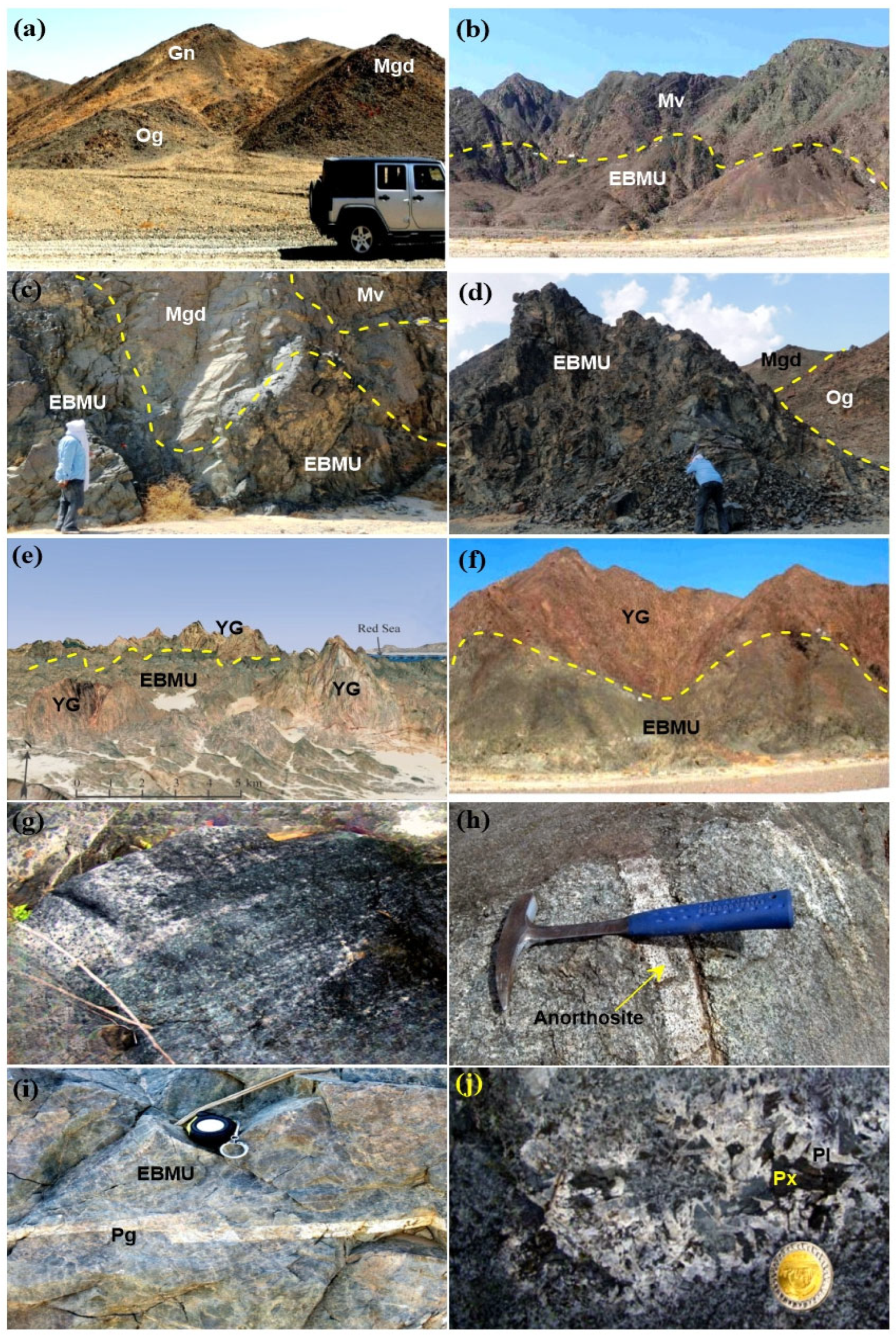

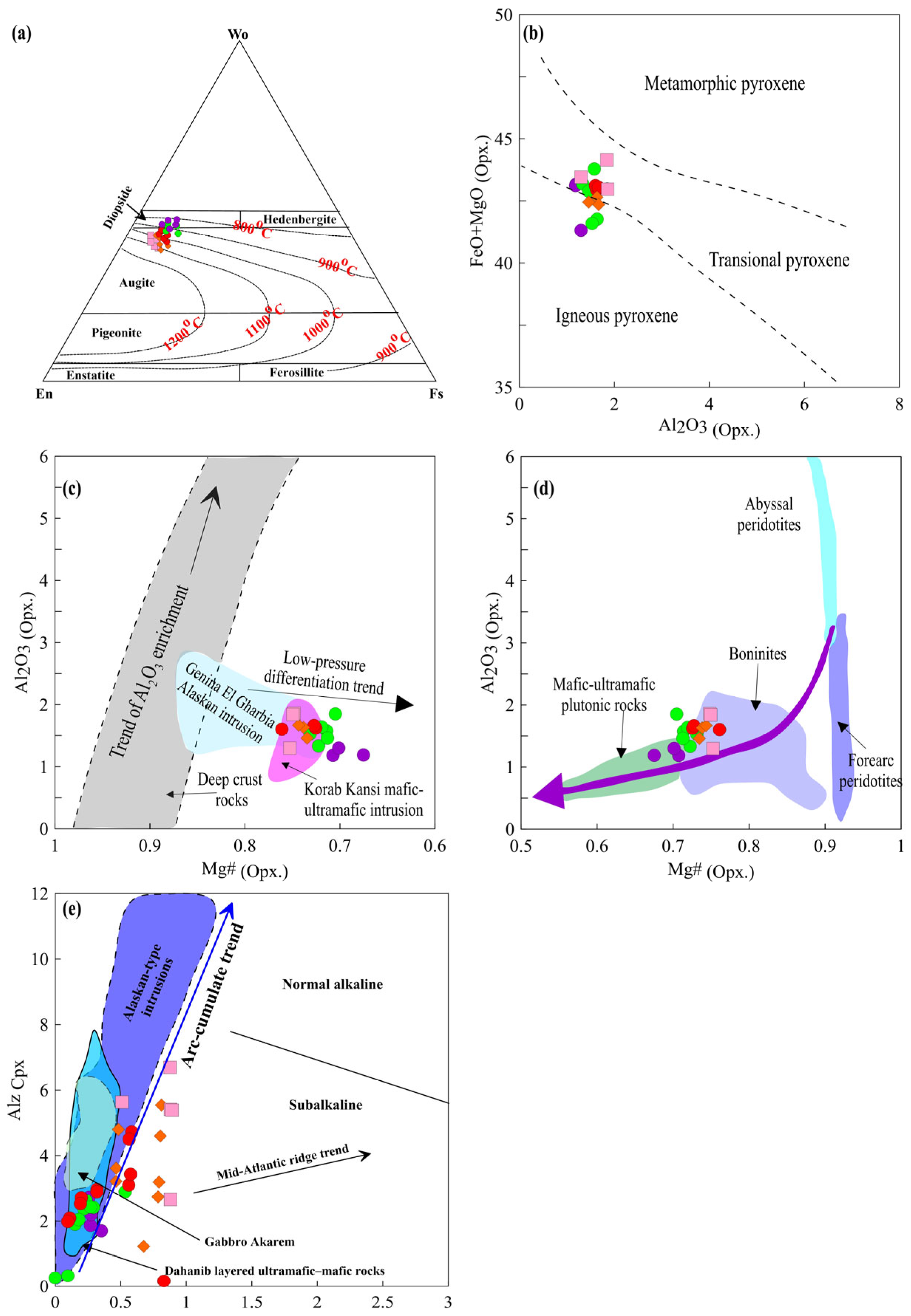
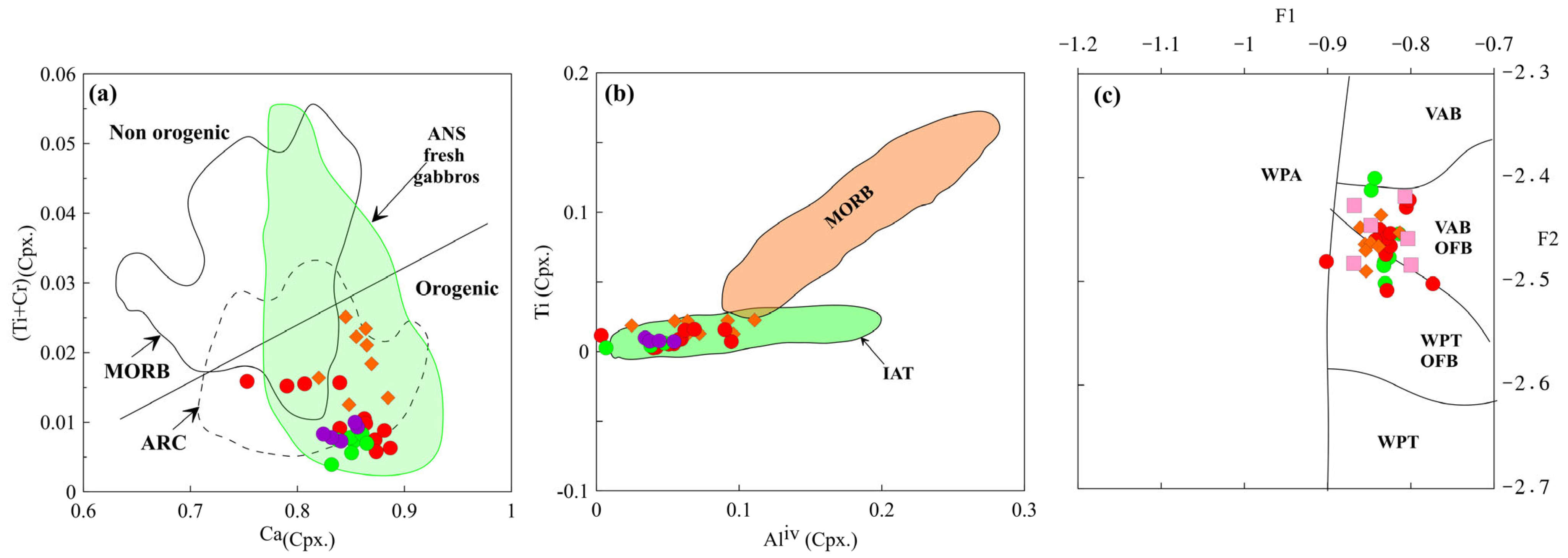
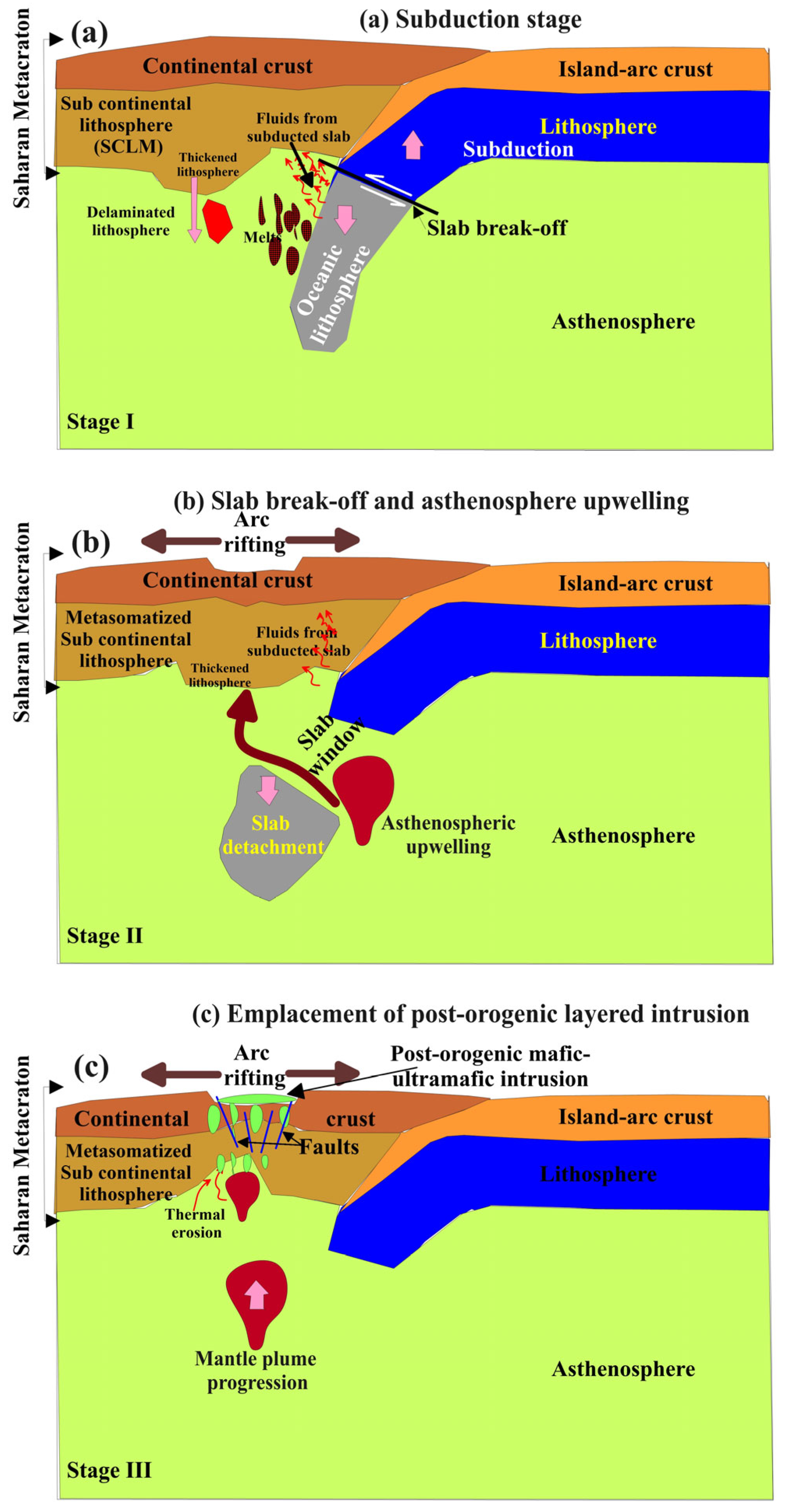
| SiO2 | MgO | Al2O3 | FeO | CaO | Na2O | K2O | MnO | TiO2 | P2O5 | |
|---|---|---|---|---|---|---|---|---|---|---|
| EBMU parental magma | 43.44 | 19.86 | 9.36 | 14.22 | 8.84 | 1.34 | 0.13 | 0.18 | 1.66 | 0.021 |
| EBMU primitive magma | 43.04 | 20.56 | 8.46 | 14.61 | 8.19 | 1.28 | 0.07 | 0.16 | 1.35 | |
| Composition of Ferropicritic magma | 43–46 | 14–20 | 8–10 | 12–16 | 8–11 | 0.5–1.5 | 0.1–0.6 | 0.2–0.3 | 1.0–2.5 | 0.1–0.3 |
Disclaimer/Publisher’s Note: The statements, opinions and data contained in all publications are solely those of the individual author(s) and contributor(s) and not of MDPI and/or the editor(s). MDPI and/or the editor(s) disclaim responsibility for any injury to people or property resulting from any ideas, methods, instructions or products referred to in the content. |
© 2025 by the authors. Licensee MDPI, Basel, Switzerland. This article is an open access article distributed under the terms and conditions of the Creative Commons Attribution (CC BY) license (https://creativecommons.org/licenses/by/4.0/).
Share and Cite
Abdelfadil, K.M.; Semary, H.E.; Asran, A.M.; Rehman, H.U.; Sami, M.; Aldukeel, A.; Mogahed, M.M. Post-Collisional Mantle Processes and Magma Evolution of the El Bola Mafic–Ultramafic Intrusion, Arabian-Nubian Shield, Egypt. Minerals 2025, 15, 705. https://doi.org/10.3390/min15070705
Abdelfadil KM, Semary HE, Asran AM, Rehman HU, Sami M, Aldukeel A, Mogahed MM. Post-Collisional Mantle Processes and Magma Evolution of the El Bola Mafic–Ultramafic Intrusion, Arabian-Nubian Shield, Egypt. Minerals. 2025; 15(7):705. https://doi.org/10.3390/min15070705
Chicago/Turabian StyleAbdelfadil, Khaled M., Hatem E. Semary, Asran M. Asran, Hafiz U. Rehman, Mabrouk Sami, A. Aldukeel, and Moustafa M. Mogahed. 2025. "Post-Collisional Mantle Processes and Magma Evolution of the El Bola Mafic–Ultramafic Intrusion, Arabian-Nubian Shield, Egypt" Minerals 15, no. 7: 705. https://doi.org/10.3390/min15070705
APA StyleAbdelfadil, K. M., Semary, H. E., Asran, A. M., Rehman, H. U., Sami, M., Aldukeel, A., & Mogahed, M. M. (2025). Post-Collisional Mantle Processes and Magma Evolution of the El Bola Mafic–Ultramafic Intrusion, Arabian-Nubian Shield, Egypt. Minerals, 15(7), 705. https://doi.org/10.3390/min15070705








